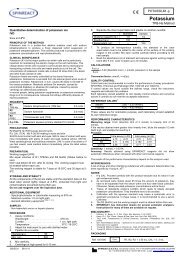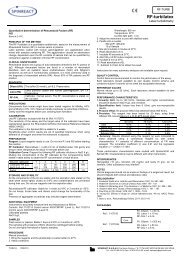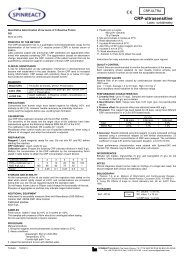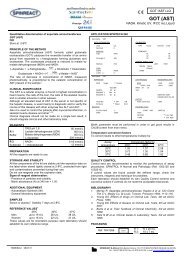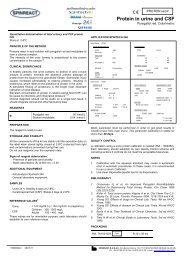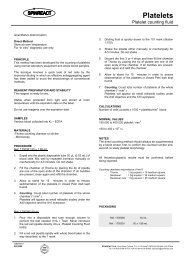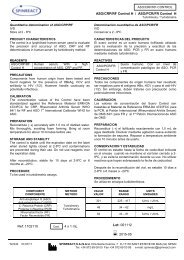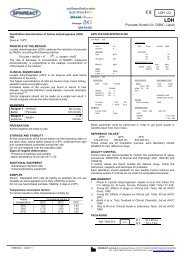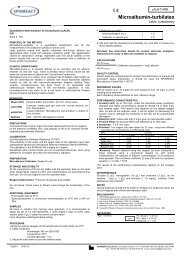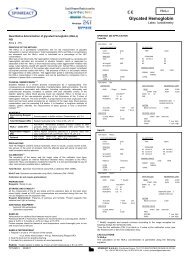Tecnicas Ingles-Español Turbilatex - Spinreact
Tecnicas Ingles-Español Turbilatex - Spinreact
Tecnicas Ingles-Español Turbilatex - Spinreact
Create successful ePaper yourself
Turn your PDF publications into a flip-book with our unique Google optimized e-Paper software.
Quantitative determination of Antithrombin III (ATRHOM-III)<br />
IVD<br />
Store 2 - 8ºC.<br />
INTENDED USE<br />
The ATROM-III is a quantitative turbidimetric test for the measurement of<br />
antithrombin III in human serum or plasma.<br />
PRINCIPLE OF THE METHOD<br />
Anti-antithrombin III antibodies when mixed with samples containing antithrombin-<br />
III, form insoluble complexes. These complexes cause an absorbance change,<br />
dependent upon the antithrombin-III concentration of the patient sample, that can<br />
be quantified by comparison from a calibrator of know antithrombin-III<br />
concentration.<br />
CLINICAL SIGNIFICANCE<br />
Antithrombin III is a protein synthesized in the liver, normally present in the human<br />
plasma. It is the major inhibitor of the thrombin, and inhibits coagulation and limits<br />
the forming of blood clots. Antithrombin-III is also capable of activating other<br />
components of the coagulation cascade (eg, factor Xa), as well as plasmin.<br />
Antithrombin-III deficiency can cause or lead to thrombosis, a clot forming in a<br />
blood vessel. Clots forming in the legs and pulmonary embolism are most<br />
commonly reported. Antithrombin-III deficiency is usually inherited and affects<br />
males and females equally. All family members should be tested if there is history<br />
of the disease.<br />
Acquired antithrombin-III deficiency can occur as a result of other conditions. It has<br />
been reported in patients with liver diseases, patients receiving certain kinds of<br />
chemotherapy, and patients using oral contraceptives.<br />
REAGENTS<br />
Diluent (R1)<br />
Antibody (R2)<br />
Tris buffer 20 mmol/L, PEG 8000, pH 8.3<br />
Sodium azide 0.95 g/L.<br />
Goat serum, anti-human antithrombin III, pH 7.5.<br />
Sodium azida 0.95 g/L.<br />
Optional Ref: 1102003 PROT CAL.<br />
CALIBRATION<br />
It must be used the PROT CAL to calibrate the reagent. The reagent (both<br />
monoreagent and bireagent) should be recalibrated every week, when the controls<br />
are out of specifications, and when changing the reagent lot or the instrument<br />
settings.<br />
PREPARATION<br />
Reagents: Ready to use.<br />
Calibration Curve: Prepare the following PROT CAL dilutions in ClNa 9 g/L as<br />
diluent. Multiply the concentration of the ATHROM-III calibrator by the<br />
corresponding factor stated in table bellow to obtain the antithrombin-III<br />
concentration of each dilution.<br />
Calibrator dilution 1 2 3 4 5 6<br />
Calibrator (µL) -- 10 25 50 75 100<br />
NaCl 9 g/L (µL) 100 90 75 50 25 -<br />
Factor 0 0.1 0.25 0.5 0.75 1.0<br />
STORAGE AND STABILITY<br />
All the components of the kit are stable until the expiration date on the label when<br />
stored tightly closed at 2-8ºC and contaminations are prevented during their use.<br />
Do not use reagents over the expiration date.<br />
Reagent deterioration: The presence of particles and turbidity.<br />
Do not freeze; frozen Antibody or Diluent could change the functionality of the test.<br />
ADDITIONAL EQUIPMENT<br />
- Thermostatic bath at 37ºC.<br />
- Spectrophotometer or photometer thermostatable at 37ºC with a 340 nm filter (320<br />
– 360 nm).<br />
SAMPLES<br />
Fresh serum or plasma. Sodium citrate should be used as anticoagulant. Stable 7<br />
days at 2-8ºC or 3 months at –20ºC.<br />
Do not use highly hemolized or lipemic samples.<br />
PROCEDURE<br />
1. Bring the reagents and the photometer (cuvette holder) to 37ºC.<br />
2. Assay conditions:<br />
Wavelength : 340 nm<br />
Temperature : 37 ºC<br />
Cuvette ligth path : 1cm<br />
3. Adjust the instrument to zero with distilled water.<br />
4. Pipette into a cuvette:<br />
Reagent R1 (µL) 800<br />
Sample or Calibrator (µL) 20<br />
ATHROM - III<br />
Antithrombin III<br />
Turbidimetry<br />
5. Mix and read the absorbance (A1) after the sample addition.<br />
6. Immediately, pipette into de cuvette:<br />
Reagent R2 (µL) 200<br />
7. Mix and read the absorbance (A2) of calibrators and sample exactly 5 minutes<br />
after the R2 addition.<br />
<strong>Spinreact</strong> has instruction sheets for several automatic analyzers.<br />
Instructions for many of them are available on request.<br />
CALCULATIONS<br />
Calculate the absorbance difference (A2-A1) of each point of the calibration curve<br />
and plot the values obtained against the antithrombin-III concentration of each<br />
calibrator dilution. Antithrombin-III concentration in the sample is calculated by<br />
interpolation of its (A2-A1) in the calibration curve.<br />
QUALITY CONTROL<br />
Control sera are recommended to monitor the performance of manual and<br />
automated assay procedures. <strong>Spinreact</strong> PROT CONTROL (Ref.:1102004) is<br />
available. Each laboratory should establish its own Quality Control scheme and<br />
corrective actions if controls do not meet the acceptable tolerances.<br />
REFERENCE VALUES<br />
Between 17 - 30 mg/dL. Each laboratory should establish its own reference<br />
range.<br />
PERFORMANCE CHARACTERISTICS<br />
1. Measurement range: Up to 70 mg/dL (Nota 1), under the described assay<br />
conditions. Samples with higher concentrations, should be diluted 1/5 in NaCl<br />
9 g/L and retested again. The linearity limit depends on the sample / reagent<br />
ratio. It will be higher by decreasing the sample volume, although the<br />
sensitivity of the test will be proportionally decreased.<br />
2. Limit detection: Values less than 7.4 mg/dL give non-reproducible results.<br />
3. Prozone effect: No prozone effect was detected upon 200 mg/dL<br />
4. Sensitivity: Δ 7.5 mA / mg/dL.<br />
5. Precision: The reagent has been tested for 20 days, using two levels of serum<br />
in a EP5-based study.<br />
EP5 CV (%)<br />
17.85 mg/dl 35.93 mg/dl<br />
Total 3.2% 3.5%<br />
Within Run 0.8% 1%<br />
Between Run 2.4% 2.4%<br />
Between Day 2% 2.3%<br />
6. Accuracy: Results obtained using this reagent did not show systematic<br />
differences when compared with reference reagents. Details of the<br />
comparison experiments are available on request.<br />
The results of the performance characteristics depend on the used analyzer.<br />
INTERFERENCES 5-6<br />
Bilirubin (up to 25 mg/dL) does not interfere. Rheumatoid factors (≥ 200 IU/mL)<br />
and lipemia (≥ 6 g/L), and hemoglobin (≥ 9 g/L), interfere. Other substances may<br />
interfere 5,6 .<br />
NOTES<br />
1. Linearity depends on the calibrator concentration.<br />
2.Clinical diagnosis should not be made on findings of a single test result, but<br />
should integrate both clinical and laboratory data.<br />
BIBLIOGRAPHY<br />
1. Clinical Guide to Laboratory Tests, Edited by NW Tietz W B Saunders Co.,<br />
Philadelphia, 483, 1983.<br />
3. Pesce AJ and Kaplan, LA. Methods in Clinical Chemistry. The CV Mosby<br />
Company, St. Louis MO, 1987.<br />
4. Buller HR et al. Critical care Medicine 1982; 10: 311.<br />
5. Kauffman et al. Am J Med 1978; 65: 607.<br />
6. Young DS.Effects of drugs on clinical laboratory tests, 4th ed. AACC Pres,<br />
1995.<br />
7. Friedman and Young. Effects of disease on clinical laboratory tests, 3tn ed.<br />
AACC Pres, 1997.<br />
PACKAGING<br />
Ref.: 1102016<br />
R1. Diluent: 1 x 40 mL<br />
R2. Antibody: 1 x 10 mL<br />
ITIS42-I 30/06/11 SPINREACT,S.A./S.A.U. Ctra.Santa Coloma, 7 E-17176 SANT ESTEVE DE BAS (GI) SPAIN<br />
Tel. +34 972 69 08 00 Fax +34 972 69 00 99 e-mail: spinreact@spinreact.com<br />
Cont.
Determinación cuantitativa de Antitrombina III (ATRHOM-III)<br />
IVD<br />
Conservar a 2 - 8ºC.<br />
USO RECOMENDADO<br />
Ensayo turbidimétrico para la cuantificación de antitrombina III en suero o plasma<br />
humano.<br />
PRINCIPIO DEL METODO<br />
Los anticuerpos antitrombina III forman compuestos insolubles cuando se<br />
combinan con la antitrombina III de la muestra del paciente, ocasionando un<br />
cambio de absorbancia proporcional a la concentración de antitrombina III en la<br />
muestra, y que puede ser cuantificada por comparación con un calibrador de<br />
antitrombina III de concentración conocida.<br />
SIGNIFICADO CLINICO<br />
La antitrombina III es una proteína sintetizada en el hígado, normalmente presente<br />
en el plasma humano. Es el inhibidor más importante de la trombina, e inhibe la<br />
coagulación y limita la formación de coágulos sanguíneos. La antitrombina III<br />
activa otros componentes de la cascada de coagulación (ej, factor Xa) , así como<br />
la plasmina.<br />
El déficit de antitrombina III puede causar o conducir a la trombosis, la formación<br />
de coágulos en los vasos sanguíneos. Los coágulos que se forman en las<br />
extremidades inferiores y el embolismo pulmonar son ejemplos típicos. La<br />
deficiencia de antitrombina III es normalmente hereditaria y afecta tanto a hombres<br />
como mujeres. Todos los miembros de una misma familia afectada por esta<br />
enfermedad deberían controlarse.<br />
La deficiencia de antitrombina III adquirida puede aparecer como resultado de<br />
otras condiciones tales enfermedades hepáticas, tratamientos de quimioterapia, o<br />
el uso de contraceptivos orales.<br />
REACTIVOS<br />
Diluyente (R1)<br />
Anticuerpo (R2)<br />
Tampón tris 20 mmol/L, PEG 8000, pH, 8,3. Azida<br />
sódica 0,95 g/L.<br />
Suero de cabra, anti-antitrombina III humana, pH 7,5.<br />
Azida sódica 0,95 g/L.<br />
Opcional: Ref: 1102003PROT CAL.<br />
CALIBRACION<br />
Debe utilizarse el PROT CAL para la Calibración. El reactivo (tanto monoreactivo<br />
como bireactivo) se debe recalibrar cada semana, cuando los controles están fuera<br />
de especificaciones, y cuando el lote de reactivo o la configuración del instrumento<br />
cambia.<br />
PREPARACIÓN<br />
Reactivos: Listos para el uso.<br />
Curva de Calibración: Preparar las siguientes diluciones del PROT CAL en ClNa<br />
9 g/L como diluyente. Para obtener las concentraciones de cada dilución de<br />
antitrombina III, multiplicar la concentración de antitrombina III del calibrador por el<br />
factor correspondiente indicado en la tabla:<br />
Dilución calibrador 1 2 3 4 5 6<br />
Calibrador (µL) -- 10 25 50 75 100<br />
ClNa 9 g/L (µL) 100 90 75 50 25 -<br />
Factor 0 0.1 0,25 0,5 0,75 1,0<br />
CONSERVACION Y ESTABILIDAD<br />
Todos los componentes del kit son estables hasta la fecha de caducidad cuando se<br />
mantienen los viales bien cerrados a 2-8ºC, y se evita la contaminación durante su<br />
uso. No utilizar reactivos que hayan sobrepasado la fecha de caducidad.<br />
Indicadores de deterioro: La presencia de partículas y turbidez.<br />
No congelar; la congelación del Anticuerpo o Diluyente puede afectar la<br />
funcionalidad de los mismos.<br />
MATERIAL ADICIONAL<br />
- Baño de agua a 37ºC.<br />
- Espectrofotómetro o fotómetro con cubeta termostatizable a 37ºC para lecturas a<br />
340 nm (320-360 nm).<br />
MUESTRAS<br />
Suero o plasma fresco, recogido con citrato sódico como anticoagulantes. Estable<br />
7 días a 2-8ºC o 3 meses a -20ºC.<br />
No utilizar muestras altamente hemolizadas o lipémicas.<br />
PROCEDIMIENTO<br />
1. Calentar los reactivos y el fotómetro (portacubetas) a 37ºC.<br />
2. Condiciones del ensayo:<br />
Longitud de onda: 340 nm<br />
Temperatura: 37ºC<br />
Paso de luz de la cubeta: 1 cm<br />
3. Ajustar el espectrofotómetro a cero frente a agua destilada.<br />
4. Pipetear en una cubeta:<br />
Reactivo R1 (µL) 800<br />
Muestra o Calibrador (µL) 20<br />
ATHROM - III<br />
Antitrombina III<br />
Turbidimetría<br />
5. Mezclar y leer la absorbancia (A1) después de la adición de la muestra.<br />
6. Inmediatamente después, pipetear en la cubeta:<br />
Reactivo R2 (µL) 200<br />
7. Mezclar y leer la absorbancia (A2) exactamente después de 5 minutos de<br />
añadir el reactivo R2.<br />
<strong>Spinreact</strong> dispone de adaptaciones detalladas a la mayoría de analizadores<br />
automáticos del mercado. Solicite la información a su distribuidor.<br />
CALCULOS<br />
Calcular la diferencia de absorbancias (A2 – A1) obtenidas para los distintos<br />
calibradores, y construir la curva de calibración de los valores obtenidos frente a<br />
las concentraciones de antitrombina III de cada dilución del Calibrador. La<br />
concentración de antitrombina III en la muestra se calcula por interpolación de<br />
su diferencia (A2– A1) en la curva de calibración.<br />
CONTROL DE CALIDAD<br />
Se recomienda utilizar sueros control para controlar los ensayos tanto en<br />
procedimiento manual como en automático. <strong>Spinreact</strong> dispone del PROT<br />
CONTROL Ref: 1102004.<br />
Cada laboratorio debería establecer su propio Control de Calidad y establecer<br />
correcciones en el caso de que los controles no cumplan con las tolerancias<br />
exigidas.<br />
VALORES DE REFERENCIA<br />
Entre 17 – 30 mg/dL. Es recomendable que cada laboratorio establezca sus<br />
propios valores de referencia.<br />
CARACTERISTICAS DEL METODO<br />
1. Rango de medida: hasta 70 mg/dL en las condiciones descritas del ensayo.<br />
Las muestras con valores superiores deben diluirse 1/5 con ClNa 9 g/L y<br />
ensayarse de nuevo. El intervalo de medida depende de la relación<br />
muestra/reactivo. Disminuyendo el volumen de muestra, se aumenta el límite<br />
superior del intervalo de medida, aunque se reduce la sensibilidad.<br />
2. Límite de detección: valores por debajo de 7,4 mg/dL dan lugar a resultados<br />
poco reproducibles.<br />
3. Sensibilidad: 7,5 mA / mg/dL.<br />
4. Efecto prozona: No se observa hasta valores de 200 mg/dL.<br />
5. Precisión: El reactivo ha sido probado durante 20 días con dos niveles<br />
diferentes de suero en un estudio basado en las normas EP5 (NCCLS).<br />
EP5 CV (%)<br />
17.85 mg/dl 35.93 mg/dl<br />
Total 3.2% 3.5%<br />
Within Run 0.8% 1%<br />
Between Run 2.4% 2.4%<br />
Between Day 2% 2.3%<br />
6. Exactitud: El comportamiento de este método fue comparado con reactivos<br />
de referencia. Los resultados obtenidos no muestran diferencias significativas.<br />
Los detalles del estudio están disponibles bajo solicitud.<br />
Las características del método pueden variar según el analizador utilizado.<br />
INTERFERENCIAS<br />
Bilirrubina ( hasta 25 mg/dL), no interfiere. La hemoglobina (≥ 9 g/L), lípidos (≥ 6<br />
g/L) y factores reumatoides ( ≥ 200 UI/mL), interfieren. Otras sustancias pueden<br />
interferir 5,6 .<br />
NOTAS<br />
1. El diagnóstico clínico no debe realizarse únicamente con los resultados de un<br />
único ensayo, sino que debe considerarse al mismo tiempo los datos clínicos<br />
del paciente.<br />
BIBLIOGRAFIA<br />
1. Clinical Guide to Laboratory Tests, Edited by NW Tietz W B Saunders Co., Philadelphia,<br />
483, 1983.<br />
3. Pesce AJ and Kaplan, LA. Methods in Clinical Chemistry. The CV Mosby Company, St.<br />
Louis MO, 1987.<br />
4. Buller HR et al. Critical care Medicine 1982; 10: 311.<br />
5. Kauffman et al. Am J Med 1978; 65: 607.<br />
6. Young DS.Effects of drugs on clinical laboratory tests, 4th ed. AACC Pres, 1995.<br />
7. Friedman and Young. Effects of disease on clinical laboratory tests, 3tn ed. AACC Pres,<br />
1997.<br />
PRESENTACION<br />
Ref.: 1102016<br />
R1. Diluyente: 1 x 40 mL<br />
R2. Anticuerpo: 1 x 10 mL<br />
ITIS42-E 30/06/11 SPINREACT,S.A./S.A.U. Ctra.Santa Coloma, 7 E-17176 SANT ESTEVE DE BAS (GI) SPAIN<br />
Tel. +34 972 69 08 00 Fax +34 972 69 00 99 e-mail: spinreact@spinreact.com<br />
Cont.



